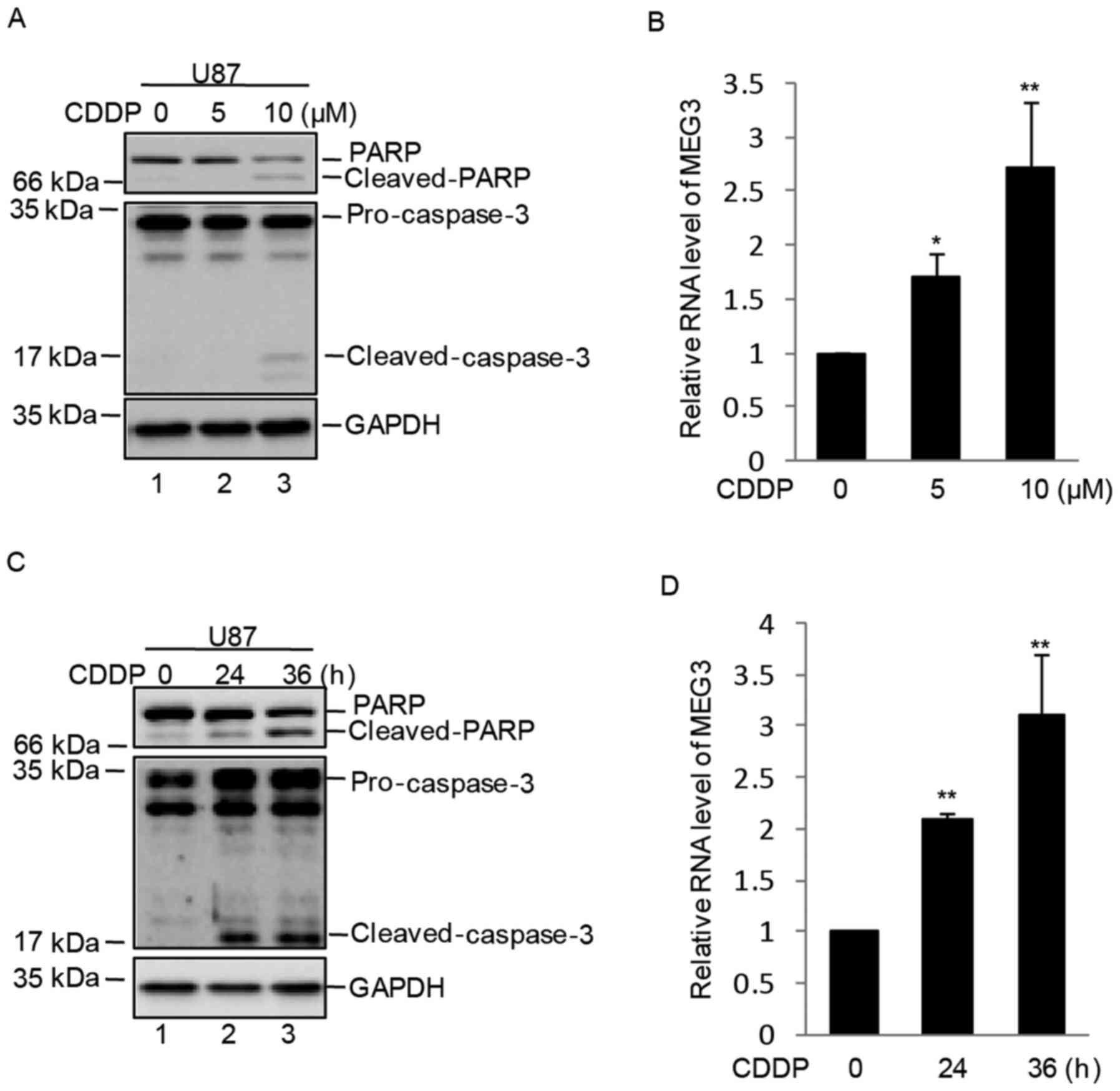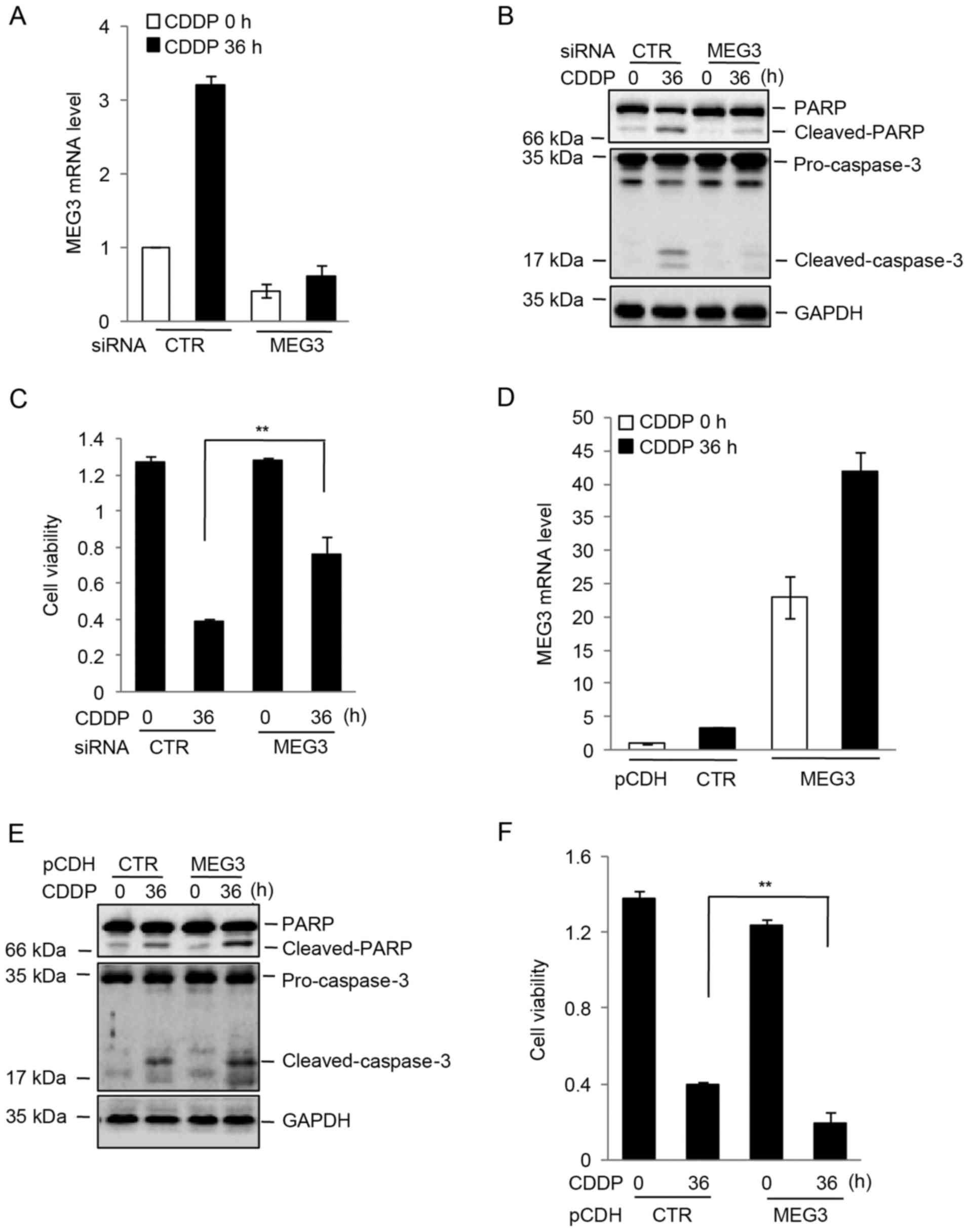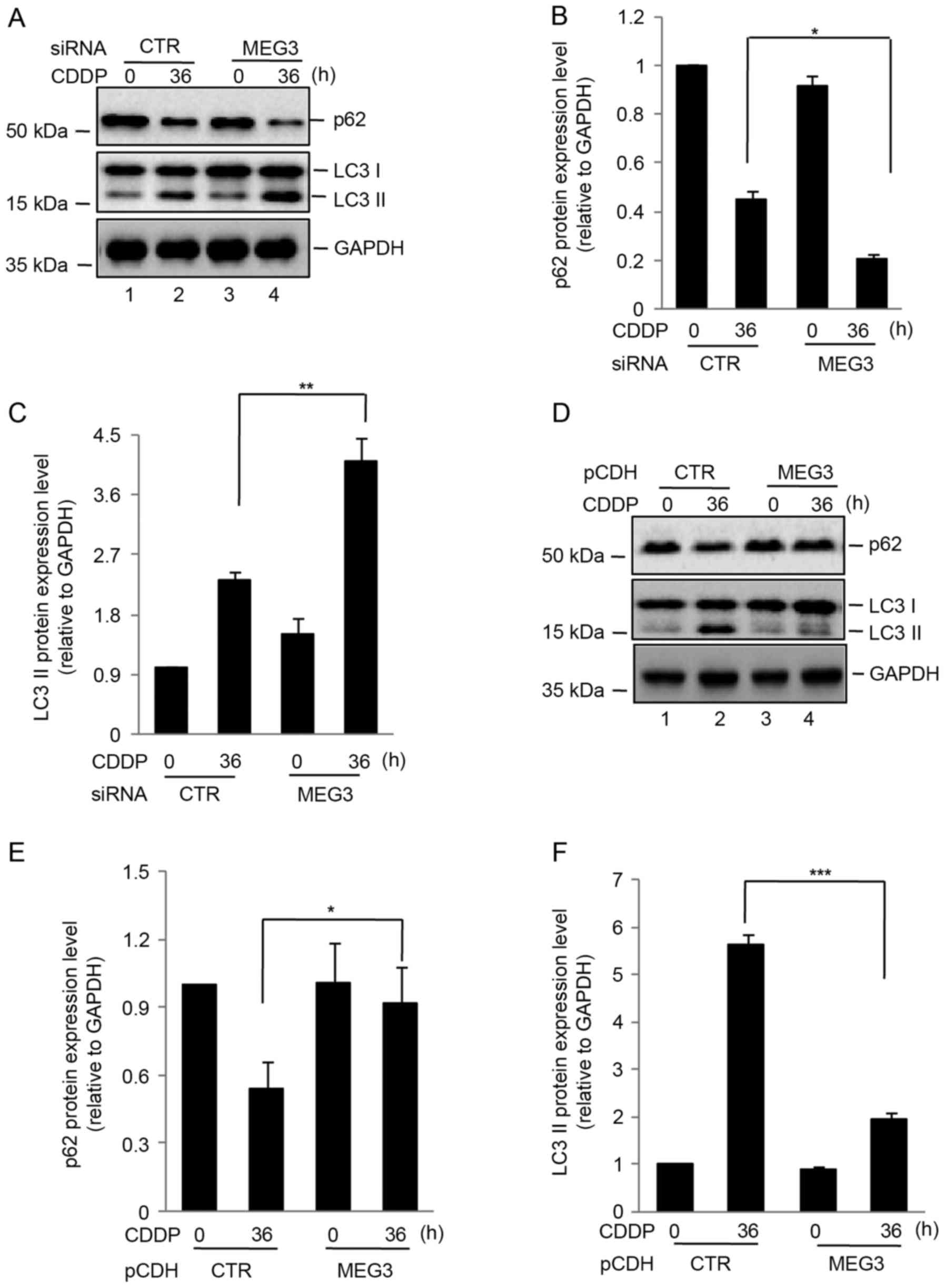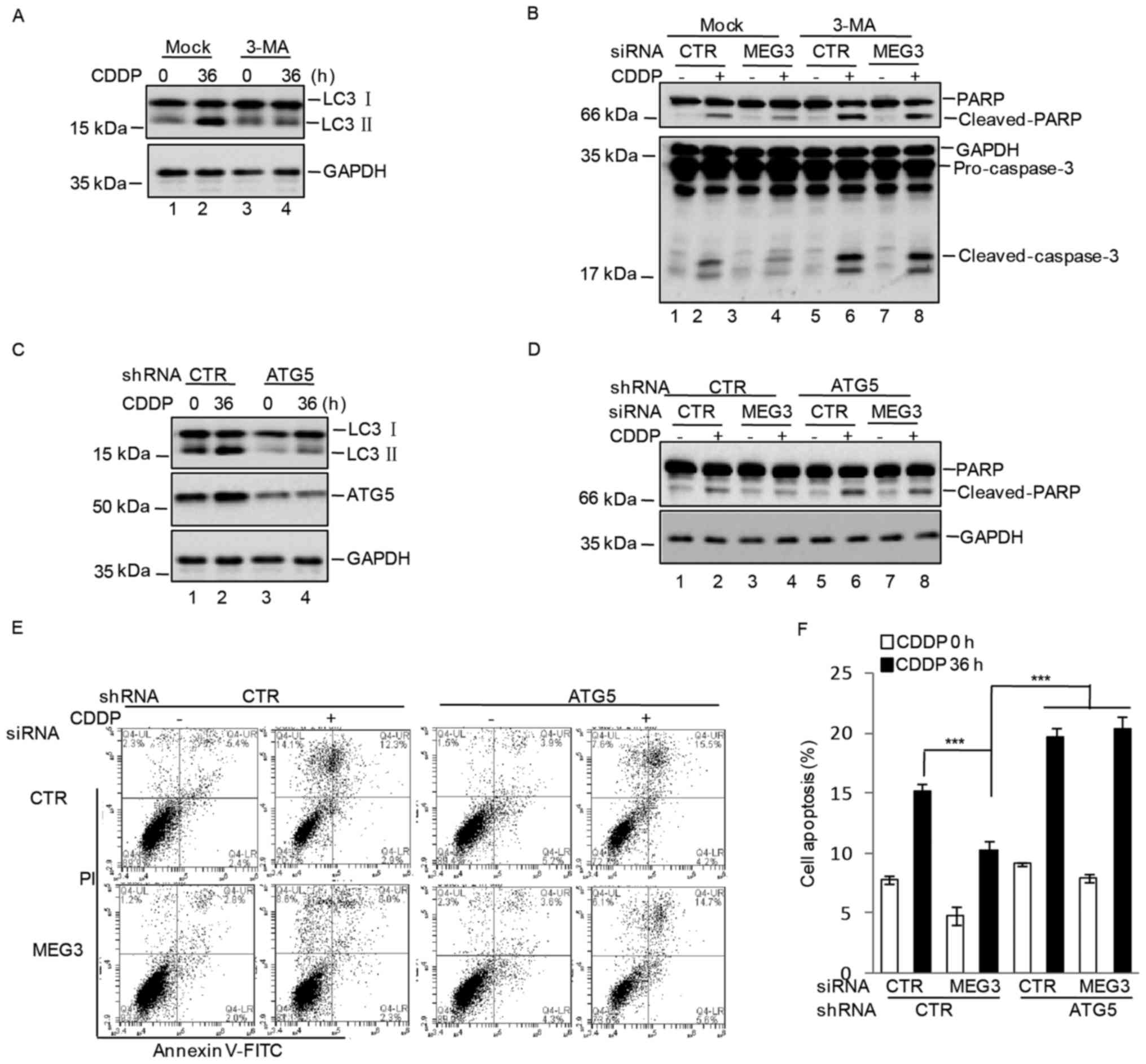Long non‑coding RNA MEG3 contributes to cisplatin‑induced apoptosis via inhibition of autophagy in human glioma cells
- Authors:
- Published online on: June 30, 2017 https://doi.org/10.3892/mmr.2017.6897
- Pages: 2946-2952
Abstract
Introduction
Glioblastoma multiforme (GBM) is one of the most fatal forms of brain cancer, and patients with this disease develop resistance to chemotherapy and radiotherapy, which is associated with a poor patient prognosis (1,2). Cisplatin is one of the first-line chemotherapeutic agents used to treat a number of human tumors, including GBM. It targets tumor cells by interacting with and damaging DNA, which induces apoptosis-mediated cell death (3). Despite an initial response, repeated clinical treatment with cisplatin usually results in the development of chemoresistance in tumor cells (4,5). Therefore, investigating the molecular mechanisms underlying cisplatin-resistance and identifying efficient combination treatments to eliminate cisplatin resistance, are urgently required for the development of effective therapeutic strategies for GBM.
The long non-coding RNA (lncRNA), maternally expressed gene 3 (MEG3), is an imprinted gene that is part of the Δ-like non-canonical notch ligand 1-MEG3 locus located on human chromosome 14q32 (6). Although MEG3 is expressed in a number of normal human tissues, particularly those of the brain and pituitary, loss of MEG3 expression has been identified in several human cancers, including bladder cancer, glioma, hepatocellular carcinoma and additional cancers (7–10). In addition, MEG3 was reported to be downregulated in human meningioma when compared with normal tissues, and was associated with tumor grade (8,11). A Previous study demonstrated that loss of MEG3 activated autophagy in bladder cancer (9). However, the effects of MEG3 on cisplatin resistance and autophagy in GBM remain elusive.
In the present study, MEG3 expression was induced by cisplatin treatment of U87 cells, and increased MEG3 expression contributed to the induction of apoptosis. In addition, overexpression of MEG3 eliminated cisplatin-induced autophagy in U87 cells. Furthermore, inhibition of autophagy by MEG3 enhanced cisplatin-induced apoptosis in U87 cells. Therefore, the results present a novel therapeutic strategy for the treatment of GBM.
Materials and methods
Cell culture
The human U87 cell line, which is likely to be a glioblastoma cell line of unknown origin (12), was obtained from the American Type Culture Collection (Manassas, VA, USA). U87 cells were cultured at 37°C and 95% humidity in minimum essential medium (cat. no. M2297; Sigma-Aldrich; Merck KGaA, Darmstadt, Germany) containing 10% fetal bovine serum (FBS; Gibco; Thermo Fisher Scientific, Inc., Waltham, MA, USA). The medium was refreshed every other day, and cells were passaged prior to reaching 100% confluence.
Reagents
The following primary antibodies were employed in the present study: Anti-caspase 3 (cat. no. 9662; dilution, 1:1,000; rabbit; Cell Signaling Technology, Inc., Danvers, MA, USA); anti-GAPDH (cat. no. SC-25778; dilution, 1:2,000; rabbit; Santa Cruz Biotechnology, Inc., Dallas, TX, USA); anti-poly (ADP) ribose polymerase (PARP; cat. no. SC-8007; dilution, 1:1,000; mouse; Santa Cruz Biotechnology, Inc.); anti-microtubule-associated proteins 1A/1B light chain 3A (LC3; cat. no. L7543; dilution, 1:1,000; rabbit; Sigma-Aldrich; Merck KGaA); anti-autophagy protein 5 (ATG5; cat. no. sc-133158; dilution, 1:500; mouse; Santa Cruz Biotechnology, Inc.) and anti-p62 (cat. no. ab109012; dilution, 1:1,000; rabbit; Abcam, Cambridge, UK). The PARP antibody was used to detect PARP and cleaved PARP, the LC3 antibody was used to detect LC3 I and LC3 II, and the caspase 3 antibody was used to detect pro-caspase-3 and cleaved-caspase-3. Horseradish peroxidase-conjugated goat anti-mouse IgG (cat. no. A21010; dilution, 1:5,000) and anti-rabbit IgG (cat. no. A21020; dilution, 1:5,000) were purchased from Abbkine Scientific Co., Ltd. (Wuhan, China). Cisplatin was purchased from Sigma-Aldrich; Merck KGaA (cat. no. P4394), and the phosphoinositide 3-kinase (PI3K) inhibitor, 3-methyladenine (3-MA), was purchased from R&D Systems, Inc. (Minneapolis, MN, USA). 3-MA inhibits autophagy by preventing autophagosome formation via the inhibition of PI3K catalytic subunit type 3 (13). 3-MA was resuspended in water, as organic solvents, such as dimethyl sulfoxide (DMSO), may be cytotoxic. Due to its instability in aqueous solutions, 50 mM stocks of 3-MA were freshly prepared, and cells were treated with 5 mM 3-MA to inhibit autophagy.
Lentivirus transfection and MEG3 knockdown
The lentiviral transduction particles for short hairpin (sh)RNA-mediated knockdown of ATG5 were purchased from Sigma-Aldrich; Merck KGaA. The shRNA sequence targeting ATG5 was 5′-CCTTTCATTCAGAAGCTGTTT-3′ and the pLKO.1 vector (Sigma-Aldrich; Merck KGaA) was used as negative control. The shRNA was cloned using the PLKO.1 vector. Stable knockdown of ATG5 in cells was achieved as previously described (14). The primer sequences, 5′-AGACGGCGGAGAGCAGAG-3′ and 5′-CACATTTATTGAGAGCACAGTGG-3′, were used to generate plasmids encoding the full-length MEG3 sequence. RNA was extracted from U87 cells using RNAiso Plus (Takara Biotechnology Co., Ltd., Dalian, China) MEG3 cDNA was then reverse transcribed using 100 µg total RNA from U87 cells and the Advantage RT-For PCR kit (Takara Biotechnology Co., Ltd.), and was amplified for 40 cycles of 95°C for 1 min, 54°C for 1 min and 72°C for 30 sec. To generate lentiviral vectors expressing MEG3, HEK293T cells (1×105/well) cultured on a 6-cm dish were transfected with 2 µg pCDH-MEG3 or pCDH vector (System Biosciences, Inc., Palo Alto, CA, USA), together with 1.5 µg psPax2 (System Biosciences, Inc.) and 0.5 µg pMD2 G (System Biosciences, Inc.) vectors using Lipofectamine 3000 (Thermo Fisher Scientific, Inc.). At 24 h following transfection, the medium was replaced with Dulbecco's modified Eagle's medium containing 10% FBS, and cells were incubated for a further 24 h. The culture medium containing lentiviral particles was centrifuged at 1,000 × g for 5 min at room temperature. Viral particles were collected in the supernatant and the concentration was determined using the Lenti-Pac™ Lentivirus Concentration Solution (GeneCopoeia, Inc., Rockville, MD, USA). The virus titer was determined by calculating the multiplicity of infection. For infection of U87 cells (1×105), 100 µl viral particles (1×108/ml) were used for 12 h. In order to establish a stable cell line, at 24 h after infection was performed, 1×105 cells that were infected by viral particles (1×108/ml) at 37°C were seeded in a 6-well plate and puromycin (5 µM) was used as a selection marker for the infected cells for 24 h at 37°C. The expression efficiency was evaluated by western blot analysis.
For knockdown of MEG3 in U87 cells, small interfering (si)RNA molecules were custom designed and synthesized by Sigma-Aldrich; Merck KGaA. The sequences of the siRNAs were as follows: Control, 5′-TACGTCCAAGGTCGGGCAGGAAGA-3′; and MEG3, 5′-GACUUAAACCAAUGCCCUA-3′. This was transfected into U87 cells (2×105/well) for 24 h using Lipofectamine 3000 and, at 36 h after transfection, cells were treated with 10 µM cisplatin for 0 or 36 h. For certain experiments, cells with or without knockdown of MEG3 were pretreated with 5 mM 3-MA or mock treatment (water) at 36 h after transfection for 6 h at 37°C to inhibit autophagy, immediately prior to treatment with 10 µM cisplatin for 0 or 36 h.
Western blot analysis
U87 cells (1×105/well) were seeded into the six well cell culture plate and subjected to various treatments as described in the above paragraphs. Total protein extracted from U87 cells using radioimmunoprecipitation assay lysis buffer (Shanghai Qcbio Science and Technologies Co., Ltd., Shanghai, China) was used for immunoblotting. Briefly, cell lysates were centrifuged at 9,000 × g for 10 min at 4°C, and the supernatant was collected. The protein concentration was determined using a BCA Protein assay kit (Pierce; Thermo Fisher Scientific, Inc.). Total protein (30–60 µg) was separated on a 12% SDS-PAGE mini-gel, followed by transfer to a nitrocellulose membrane. The membranes were blocked with 5% fat-free dry milk in a Tris-buffered saline plus Tween-20 solution, consisting of 50 mM Tris-HCl, 0.15 M NaCl and 0.1% Tween-20 (pH 7.5), overnight at 4°C. Membranes were then incubated with primary antibodies overnight at 4°C and incubated with the secondary antibodies (1:5,000) at room temperature for 1 h. An enhanced chemiluminescence detection system (GE Healthcare, Chicago, IL, USA) was used to visualize the expression of target proteins. Three samples from each group were analyzed, and the results were quantified using the Gel-Pro analyzer software (version, 4.0, GE Healthcare).
Cell viability
U87 cells (2×104/well) were seeded in 96-well plates and incubated for 24 h. Cells were then treated with 10 µM cisplatin for 36 h at 37°C. MTT reagent (0.5 mg/ml; Cayman Chemical Company, Ann Arbor, MI, USA) was subsequently added, and cells were incubated for 4 h before the medium was removed and 100 µl DMSO was added. Cell viability was quantified by measuring the optical density (OD) at 490 nm using a microplate reader (Bio-Rad Laboratories, Inc., Hercules, CA, USA). At least three independent experiments were performed, and the final inhibitory rate of cell viability was calculated using the following formula: Inhibitory rate = [1 - (OD490compound/OD490solvent)] × 100.
Annexin V-fluorescein isothiocyanate (FITC) staining and fluorescence-activated cell sorting (FACS)
The staining protocol was performed using a FITC Annexin V Apoptosis Detection kit I (BD Biosciences, Franklin Lakes, NJ, USA), according to the manufacturer's protocol. Briefly, 5×105 cells were transfected with 100 µl pLKO.1 (1×108/ml) as a control or 100 µl shRNA ATG5 (1×108/ml) for 12 h at 37°C and, immediately following infection, the cells were transfected with control or MEG3 siRNA at 37°C. After transfection for 24 h, the cells were treated with 10 µM cisplatin for 36 h at 37°C. Cells were subsequently centrifuged at 1,000 × g for 5 min at 4°C and resuspended in 195 µl binding buffer. This was followed by incubation with 5 µl Annexin V-FITC for 10 min at room temperature in the dark. The cells were centrifuged again at 1,000 × g for 5 min at 4°C, before they were resuspended in 190 µl binding buffer and 10 µl propidium iodide stain and gently agitated. FACS analysis was performed using the BD Accuri C6 Flow Cytometer (BD Biosciences) in order to detect cell apoptosis and the apoptosis was analyzed using CFlow Plus software (version, 1.0264.15; BD Biosciences).
RNA extraction and reverse transcription-quantitative polymerase chain reaction (RT-qPCR)
U87 cells (2×105/well) were treated with 5 or 10 µM cisplatin for 0, 24 or 36 h, prior to RNA extraction using RNAiso Plus. RNA quality was examined by gel electrophoresis, and only high quality RNA was used for subsequent analyses. A total of 1 µg total RNA was used to synthesize cDNA using the PrimeScript™ RT reagent kit (Perfect Real Time; Takara Biotechnology Co., Ltd.) according to the manufacturer's instructions. qPCR was performed using SYBR premix ExTaq (Takara Biotechnology Co., Ltd.) and ROX, and amplified with the Stratagene Mx3000P qPCR system (Agilent Technologies, Inc., Santa Clara, CA, USA). The primer sequences used for qPCR analysis were as follows: Actin forward, 5′-CTCCATCCTGGCCTCGCTGT-3′, and reverse, 5′-GCTGTCACCTTCACCGTTCC-3′; MEG3 forward, 5′-GCATTAAGCCCTGACCTTTG-3′, and reverse, 5′-TCCAGTTTGCTAGCAGGTGA-3′. The mRNA expression was normalized to the expression of actin using the 2-∆∆Cq method (15).
Statistical analysis
Data are presented as the mean ± standard deviation, and statistical analysis was performed using SPSS software (version, 22.0; IBM Corp., Armonk, NY, USA). Statistical analysis was performed using one-way analysis of variance followed by Dunnett's test. P<0.05 was considered to indicate a statistically significant difference.
Results
MEG3 lncRNA is induced by cisplatin treatment of human U87 cells
In order to evaluate MEG3 expression in response to cisplatin treatment of GBM, human U87 cells were treated with 0, 5 or 10 µM cisplatin for 36 h. As shown in Fig. 1A, U87 cells were treated with 0, 5 or 10 µM cisplatin for 24 h and cell apoptosis was increased at 10 µM cisplatin as indicated by increased PARP and caspase-3 cleavage. Subsequently, the mRNA expression of MEG3 was detected using RT-qPCR and the results demonstrated that the mRNA expression levels of MEG3 were increased in a dose-dependent manner following treatment of U87 cells with cisplatin (Fig. 1B). The cells were subsequently treated with 10 µM cisplatin for 0, 24 or 36 h. As shown in Fig. 1C, cell apoptosis was increased at 24 and 36 h, as indicated by increased PARP and caspase-3 cleavage. In addition, the expression levels of MEG3 were significantly upregulated in a time-dependent manner in U87 cells (Fig. 1D).
MEG3 lncRNA promotes cisplatin-induced apoptosis in U87 cells
To determine whether elevated MEG3 affected cell survival following cisplatin treatment, MEG3 expression was inhibited by siRNA in U87 cells. The expression level of MEG3 was markedly downregulated in MEG3-siRNA transfected U87 cells when compared with those transfected with control siRNA (Fig. 2A). The cells were subsequently treated with cisplatin for 0 or 36 h. When compared with cells transfected with control siRNA, inhibition of MEG3 reduced the protein expression levels of cleaved PARP (Fig. 2B). Similarly, decreased MEG3 expression attenuated the cisplatin-induced reduction in cell viability (Fig. 2C). Conversely, exogenous expression of MEG3 efficiently enhanced the effects of cisplatin on the protein expression levels of cleaved PARP and cell viability (Fig. 2D-F).
MEG3 lncRNA inhibits cisplatin-induced autophagy
A previous study demonstrated that loss of MEG3 expression activated autophagy and increased the proliferation of bladder cancer cells (9). In order to investigate the effect of MEG3 on autophagy induced by cisplatin, U87 cells transfected with control MEG3 siRNA were treated with cisplatin for 0 or 36 h. Compared with the control cells, silencing of MEG3 expression increased the protein expression of LC3 II relative to GAPDH and promoted p62 degradation (Fig. 3A-C). By contrast, overexpression of MEG3 attenuated cisplatin-induced autophagy in U87 cells (Fig. 3D-F).
LncRNA MEG3 enhances cisplatin-induced apoptosis via suppression of autophagy
Autophagy has been demonstrated to be a key mechanism that induces chemoresistance in cancer cells (9). Therefore, the present study investigated whether the effects of MEG3 in promoting cisplatin-induced apoptosis was dependent on the inhibition of autophagy. U87 cells transfected with control or MEG3 siRNA were pretreated with 3-MA (5 mM) for 6 h and exposed to 10 µM cisplatin for 0 or 36 h. Cell apoptosis was analyzed. Compared with control siRNA-transfected cells, inhibition of MEG3 markedly decreased the expression of apoptosis-associated proteins, which was reversed following treatment with the autophagy inhibitor, 3-MA (Fig. 4A and B). To confirm these observations, cells were infected with lentiviruses expressing shRNA targeting ATG5, which is a key molecule involved in the formation of autophagic vacuoles and induces autophagy (16). The cells were treated with control or MEG3 siRNA. When compared with control shRNA-transfected U87 cells that were transfected with MEG3 siRNA, knockdown of ATG5 significantly increased the level of apoptosis (Fig. 4C-F). These data indicated that inhibition of autophagy by MEG3 promoted cisplatin-induced apoptosis of U87 cells.
Discussion
LncRNAs, which were initially thought to be spurious transcriptional ‘noise’, have been reported to participate in a broad spectrum of biological processes, including maintenance of genome integrity, cell differentiation and embryonic development (17). In different types of cancer cells, lncRNAs have been demonstrated to be involved in tumorigenesis and chemoresistance (18).
The MEG3 lncRNA has been suggested to function as a tumor suppressor in a number of human cancers, and the expression level of MEG3 is significantly downregulated in several primary cancers (6,8). A recent report indicated that MEG3 contributes to cisplatin-induced apoptosis in human lung cancer cells (19). Similarly, the results of the present study suggested that MEG3 expression was induced by cisplatin treatment of human U87 cells in a time- and dose-dependent manner. Silencing of MEG3 expression using siRNAs inhibited cisplatin-induced apoptosis in U87 cells. By contrast, exogenous MEG3 expression enhanced cisplatin-induced cell apoptosis.
Previous studies have revealed that autophagy is involved in mediating chemoresistance to cisplatin in several cancer cell types (4,20). In the present study, MEG3 was observed to regulate cisplatin-induced autophagy in U87 cells, as inhibition of MEG3 expression promoted autophagy of cells treated with cisplatin. However, the molecular mechanisms underlying these effects remain unclear, and future studies will investigate this further. The results of the current study demonstrated that inhibition of autophagy by 3-MA or knockdown of ATG5 reversed the decrease in cell apoptosis caused by MEG3 knockdown in U87 cells treated with cisplatin. Therefore, the results suggest that MEG3 enhances cisplatin-induced apoptosis via inhibition of autophagy in U87 cells and, therefore, MEG3 maybe considered a novel therapeutic target to counteract cisplatin-resistant gliomas.
Acknowledgements
The present study was supported by the National Nature Science Foundation of China (grant nos. 81372714, 81672480 and 81603448).
References
|
Van Meir EG, Hadjipanayis CG, Norden AD, Shu HK, Wen PY and Olson JJ: Exciting new advances in neuro-oncology: The avenue to a cure for malignant glioma. CA Cancer J Clin. 60:166–193. 2010. View Article : Google Scholar : PubMed/NCBI | |
|
Wen PY and Kesari S: Malignant gliomas in adults. N Engl J Med. 359:492–507. 2008. View Article : Google Scholar : PubMed/NCBI | |
|
Kelland L: The resurgence of platinum-based cancer chemotherapy. Nat Rev Cancer. 7:573–584. 2007. View Article : Google Scholar : PubMed/NCBI | |
|
Liu X, Sun K, Wang H and Dai Y: Knockdown of retinoblastoma protein may sensitize glioma cells to cisplatin through inhibition of autophagy. Neurosci Lett. 620:137–142. 2016. View Article : Google Scholar : PubMed/NCBI | |
|
Wainwright DA, Nigam P, Thaci B, Dey M and Lesniak MS: Recent developments on immunotherapy for brain cancer. Expert Opin Emerg Drugs. 17:181–202. 2012. View Article : Google Scholar : PubMed/NCBI | |
|
Miyoshi N, Wagatsuma H, Wakana S, Shiroishi T, Nomura M, Aisaka K, Kohda T, Surani MA, Kaneko-Ishino T and Ishino F: Identification of an imprinted gene, Meg3/Gtl2 and its human homologue MEG3, first mapped on mouse distal chromosome 12 and human chromosome 14q. Genes Cells. 5:211–220. 2000. View Article : Google Scholar : PubMed/NCBI | |
|
Anwar SL, Krech T, Hasemeier B, Schipper E, Schweitzer N, Vogel A, Kreipe H and Lehmann U: Loss of imprinting and allelic switching at the DLK1-MEG3 locus in human hepatocellular carcinoma. PloS One. 7:e494622012. View Article : Google Scholar : PubMed/NCBI | |
|
Balik V, Srovnal J, Sulla I, Kalita O, Foltanova T, Vaverka M, Hrabalek L and Hajduch M: MEG3: A novel long noncoding potentially tumour-suppressing RNA in meningiomas. J Neurooncol. 112:1–8. 2013. View Article : Google Scholar : PubMed/NCBI | |
|
Ying L, Huang Y, Chen H, Wang Y, Xia L, Chen Y, Liu Y and Qiu F: Downregulated MEG3 activates autophagy and increases cell proliferation in bladder cancer. Mol Biosyst. 9:407–411. 2013. View Article : Google Scholar : PubMed/NCBI | |
|
Zhou Y, Zhang X and Klibanski A: MEG3 noncoding RNA: A tumor suppressor. J Mol Endocrinol. 48:R45–R53. 2012. View Article : Google Scholar : PubMed/NCBI | |
|
Zhang X, Gejman R, Mahta A, Zhong Y, Rice KA, Zhou Y, Cheunsuchon P, Louis DN and Klibanski A: Maternally expressed gene 3, an imprinted noncoding RNA gene, is associated with meningioma pathogenesis and progression. Cancer Res. 70:2350–2358. 2010. View Article : Google Scholar : PubMed/NCBI | |
|
Allen M, Bjerke M, Edlund H, Nelander S and Westermark B: Origin of the U87MG glioma cell line: Good news and bad news. Sci Transl Med. 8:354re32016. View Article : Google Scholar : PubMed/NCBI | |
|
Miller S, Oleksy A, Perisic O and Williams RL: Finding a fitting shoe for Cinderella: Searching for an autophagy inhibitor. Autophagy. 6:805–807. 2010. View Article : Google Scholar : PubMed/NCBI | |
|
Han C, Gu H, Wang J, Lu W, Mei Y and Wu M: Regulation of L-threonine dehydrogenase in somatic cell reprogramming. Stem Cells. 31:953–965. 2013. View Article : Google Scholar : PubMed/NCBI | |
|
Livak KJ and Schmittgen TD: Analysis of relative gene expression data using real-time quantitative PCR and the 2(−Delta Delta C(T)) methods. Methods. 25:402–408. 2001. View Article : Google Scholar : PubMed/NCBI | |
|
Noda NN and Inagaki F: Mechanisms of autophagy. Annu Rev Biophys. 44:101–122. 2015. View Article : Google Scholar : PubMed/NCBI | |
|
Schmitt AM and Chang HY: Long noncoding RNAs in cancer pathways. Cancer Cell. 29:452–463. 2016. View Article : Google Scholar : PubMed/NCBI | |
|
Wu P, Zuo X, Deng H, Liu X, Liu L and Ji A: Roles of long noncoding RNAs in brain development, functional diversification and neurodegenerative diseases. Brain Res Bull. 97:69–80. 2013. View Article : Google Scholar : PubMed/NCBI | |
|
Liu J, Wan L, Lu K, Sun M, Pan X, Zhang P, Lu B, Liu G and Wang Z: The long noncoding RNA MEG3 contributes to cisplatin resistance of human lung adenocarcinoma. PLoS One. 10:e01145862015. View Article : Google Scholar : PubMed/NCBI | |
|
Yang X, Du T, Wang X, Zhang Y, Hu W, Du X, Miao L and Han C: IDH1, a CHOP and C/EBPβ-responsive gene under ER stress, sensitizes human melanoma cells to hypoxia-induced apoptosis. Cancer Lett. 365:201–210. 2015. View Article : Google Scholar : PubMed/NCBI |













